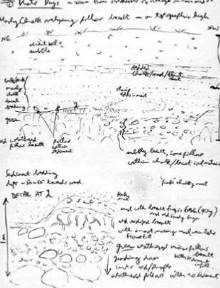
Learning to scan the landscape and pick out essential information was a vital survival tool in human evolution, so it may seem unnecessary to teach students how to observe. But though we may be hard-wired to use our eyes efficiently, growing up in an industrialised society offers fewer opportunities to practice observation skills. Equally, ‘essential information’ is different in each disciplinary context.
Students in most disciplines need to develop observational skills, whether in relation to artefacts (eg in art, design, architecture, visual culture, design history, media studies), natural phenomena (eg geography, geology, physical sciences) or human subjects (eg medicine and other health professions, social sciences).
How can we help students learn to sharpen these abilities, to record relevant data accurately, and to evaluate the use of drawing, photography, and other graphic and verbal forms of notation as tools for recording?
Drawing is a particular valuable way to improve observation skills. Genetic scientist Adelaide Carpenter, explained: “In my experience, the only way to be sure I’m looking carefully enough at something – particularly something with lots of detail – is to draw it. The vital importance of this is that there may be something new and unexpected there; unless I draw I won’t look carefully enough to see the unexpected.” [in Phipps, B. Lines of Enquiry: thinking through drawing (2006)]
Whether looking down a microscope, or studying geological features on a field trip, drawing forces us to pay closer attention to what we see, to look for longer and to ask ‘What is this I am looking at? Why does it look like this? How else might it look? How does it relate and compare to what else I know?’
Show students your own field notes, and encourage them to examine each other’s notes – in class or in the field – to explore the different ways that information is recorded, discuss mark-making strategies or standard conventions for recording features, and consider what has been included or omitted.
In large classes, digital visualisers can project a live image of a drawing being created by the lecturer in real time, to demonstrate how and why particular information is recorded, and how to annotate it.
Resources and links to support the use of drawing in different subject areas can be found in the Drawing to Learn section of this website.
Other useful strategies include:
- Subject-specific checklists and mnemonics may help students to grasp what is most relevant or significant to their discipline – something that academics can take for granted and need to make explicit.
- Equally, one study of medical students showed benefits in looking at artworks which had no connection with their subject. Because they did not know what was significant, they were forced to attend to every detail equally, and this led to measurable improvements in their assessed clinical observation skills.
- Time spent thinking in advance about what questions the observation is intended to answer or to generate, can also help to focus students’ looking, as can writing or dictating descriptive notes as they go along.
Some other resources:
- Learning to look: developing clinical observational skills at an art museum
- Teaching Participant-Observation Research Methods: A Skills-Building Approach Anthropology & Education Quarterly Vol. 11, No. 1 (Spring, 1980), pp. 38-54
- Techniques for drawing botanical subjects under the microscope
- Biology Drawing Skills Handbook



